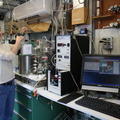One of the major activities of the PMEL Carbon Group is to conduct the highest quality analyses of inorganic carbon parameters to address the variety of research questions described throughout this web site. Many of these measurements are made at sea during hydrographic cruises, but we also analyze a growing number of samples in the laboratory that have been collected either at sea during cruises lacking instrumentation for shipboard analysis or in the laboratory to verify experimental conditions for ocean acidification experiments. We collaborate with a wide variety of partners within NOAA, in other agencies, and in the academic, private, and NGO sectors in this capacity.
The oceanic inorganic carbon system has four measurable parameters: pH, dissolved inorganic carbon (DIC), total alkalinity (TA), and the partial pressure of CO2 (pCO2). In addition, there are a number of carbon system parameters that cannot be measured directly with available technology but that are particularly relevant to ocean acidification studies, including the saturation state of carbonate-bearing, biogenic minerals such as aragonite and calcite, and the concentration of the carbonate ion (CO32-), both of which are related to the ability of calcareous organisms to extract carbonate from seawater to form their skeletons or shells. The measurement of any two of the four measurable carbon system parameters, along with temperature, salinity, and nutrient concentrations, allows the calculation of all other values in the carbon system using programs like CO2SYS, seacarb, or CO2calc. Because the rate of change in pH related to ocean acidification is so slow (0.002 units/year), it is not possible to measure pH with sufficient accuracy and precision using widely available potentiometric pH sensors, which are notoriously drift-prone. Rather, it is preferable to measure DIC and TA, for which the most robust methods are currently available, and to calculate pH, saturation state, and other parameters of interest.
Both the DIC and TA methods we employ in our laboratory are among the community standard analytical methods for ocean carbon measurements (Dickson et al. 2007). In our laboratory, DIC is analyzed coulometrically, following the method of Johnson et al. (1985, 1987). The precision and accuracy of DIC analyses are on the order of ± 0.05% in a laboratory setting. Total alkalinity is measured using the potentiometric titration method (Dickson et al. 2003). The precision and accuracy of TA analyses are on the order of ± 0.1% in a laboratory setting.
MISSION STATEMENT
The PMEL Carbon Group is committed to providing carbon measurements of the highest quality to the community interested in the global carbon cycle, climate change, and ocean acidification.
References
A.G. Dickson, J.D. Afghan, and G.C. Anderson. 2003. Reference materials for oceanic CO2 analysis: a method for the certification of total alkalinity. Marine Chemistry, 80: 185–197.
Johnson, K.M., A.E. King, and J.M. Sieburth. 1985. Coulometric TCO2 analyses for marine studies: An introduction. Marine Chemistry, 16: 61-82.
Johnson, K.M., P.J. Williams, L. Brandstrom, and J.M. Sieburth. 1987. Coulometric total carbon analysis for marine studies: Automation and calibration. Marine Chemistry, 21: 117-33.



